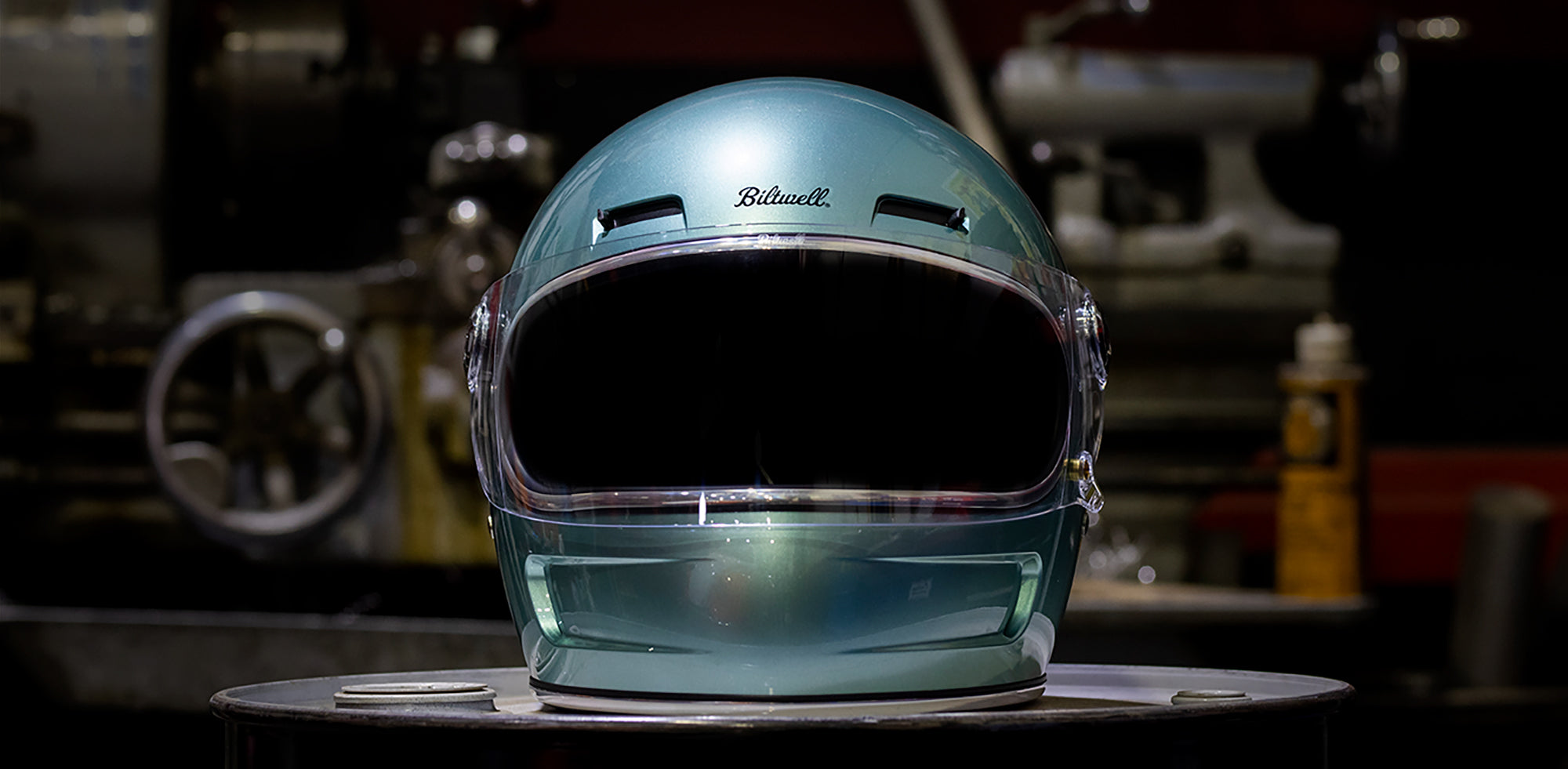For any motorcycle helmet to perform its main function—namely, to provide protection during an accident—it must fit snugly and comfortably on your head. Every Biltwell Lane Splitter—and every Gringo and Gringo S manufactured in 2019 or later—features construction and protection technologies that meet both US DOT and European ECE R22.05 safety standards. These technologies include but aren’t limited to the helmet’s injection-molded ABS outer shell, a multi-piece internal safety liner constructed with EPS foam, and a molded urethane chin bar pad. To make these internal components more comfortable on your head, every Biltwell helmet features a padded comfort liner with two cheek pads. This three-piece liner kit is removable for cleaning, and replaceable when wear and tear take their toll. High-performance, safety-certified helmets like ours can and often do last much longer than the softly padded, hand-stitched comfort liner and cheek pads inside them, just as a premium-grade boot will last longer than a pair of socks. Taking this footwear analogy one step further (please pardon the pun), when the socks on your feet are too thick or too thin, even the best hand-crafted boots will feel uncomfortable after a day of riding. Fortunately, we offer cheek pads in a range of thicknesses so you can fine-tune your Biltwell helmet for greater comfort and safety. Before you pursue this option, let’s make sure the helmet you’re wearing is the right size. Don’t laugh—people make this mistake all the time.
Measure Twice, Buy Once
Like jackets, sneakers, and virtually every other garment sold by size, different brands marked with the same size can and often do fit differently. Just because you’re an M in Helmet X doesn’t mean you’re an M in a Biltwell. You might own a dozen pair of identically-sized blue jeans—how many fit exactly the same? On hand-made products like pants, boots, and motorcycle helmets, fluctuations in fit and sizing can and often do occur. If you’re considering a Biltwell helmet for the first time, watch this video. It shows how to measure your head correctly to choose the right helmet size, and answers questions we hear from other bikeriders all the time:
A Word About Head Measurements and Helmet Sizes
This video shows how to measure the circumference of your head in inches. The sizing charts for every helmet model on our website show what helmet size you should select based on your head measurement. There is a measurement shown in centimeters (cm) printed on the size tag INSIDE every Biltwell helmet. DO NOT confuse these numbers for your head measurement. Rather, these numbers refer to the interior circumference of the helmet, NOT your head’s measurement. Now that this is clear, let’s learn how to test for correct helmet fit.
How to Check Helmet Fit
Never wear a helmet that does not fit snugly and correctly on your head. Follow these steps to determine if your helmet provides the correct fit:
- Grasp both loose neck straps, one in each hand.
- Put the opening of the helmet on top of your head and pull the straps gently outward and down until your head is firmly and comfortably inside the helmet. Do not fasten the neck strap.
- Stiffen the muscles in your neck to hold your head in a stationary position, eyes forward.
- Grasp the helmet chin bar with both hands and move the helmet gently but forcefully from side to side. Repeat the same test, but in an up and down motion.
A correct-fitting helmet will move the skin on your cheeks side to side and the skin on your forehead up and down without rotating the helmet on your head. If you feel pressure or discomfort against any part of your skull, but especially against your forehead or temples, test fit a larger helmet. If the helmet moves around your head easily without moving the skin on your forehead and cheeks, test fit the next size down. A helmet that doesn’t fit your head properly will not provide adequate protection during an accident.
Fit Factors to Consider
The stock cheek pads inside your Biltwell helmet were selected to provide comfort and security on a wide range of different-shaped faces across six different helmet sizes. That being said, these cheek pads were tested in a laboratory on a metal crash-test dummy—not living human heads with thick beards, big ears, fleshy cheeks, or other variables. If you did the fit test described above and your helmet feels too tight—or worse, too loose—we offer a wide range of accessory cheek pads in different thicknesses so you can customize your Biltwell helmet for a perfect fit.
Selecting the Right Cheek Pads For Your Helmet
The charts below show the thickness in millimeters for the STOCK CHEEK PADS on every model and size of Biltwell full-face helmet. Here’s how to use these charts to select different cheek pads for your helmet:
- Find your helmet model and size on either chart (we’ll use a MEDIUM GRINGO S for this exercise). As the chart shows, the stock cheek pads on this helmet are 19mm thick.
- IF YOUR STOCK CHEEK PADS FEEL TOO TIGHT, you have three choices for THINNER replacements: 5mm, 10mm or 15mm (see third row THINNER CHEEK PADS on GRINGO/GRINGO S chart)
- IF YOUR STOCK CHEEK PADS FEEL TOO LOOSE, you have four choices for THICKER replacements: 24mm, 29mm, 33mm, 38mm (see fourth row of chart).


Simple, right? Except now your next question might be:
“There’s so many different sizes—how do I choose the right thickness?”
Unfortunately, many variables come into play on this matter; only you can determine how snugly or loosely your helmet fits against your face. If the stock 19mm cheek pads in our example feel super tight, you might consider going down to the 10mm thick replacement. If your cheeks and/or beard are particularly full, the 5mm accessory pads might be more appropriate—only you can make this call.
Conversely, for riders with thin cheeks or narrow faces, thicker pads in the 24mm or 33mm size might be more appropriate. Again, descriptors like “super tight” or “really loose” are subjective and vague. Remember—like the best-made boots we talked about earlier, you need to give your new Biltwell helmet time to “break in” before trying to customize its fit with different cheek pads. Also, NEVER cut, drill, sand, or modify ANY part of your helmet to change the way it fits—doing so will greatly compromise the helmet’s ability to absorb energy and dissipate impacts during a crash. Armed with this tutorial and any choice from the broad range of cheek pads available on this website, you should now be able to customize the fit of your Biltwell helmet perfectly.
 Odds & Ends
Odds & Ends Parts & Labor Expo
Parts & Labor Expo Biltwell 100
Biltwell 100 El Diablo Run
El Diablo Run People's Champ
People's Champ Helmet Auction
Helmet Auction Motofest
Motofest Kernville Kampout
Kernville Kampout WTF Blog
WTF Blog P&L Magazine
P&L Magazine P&L Podcast
P&L Podcast




